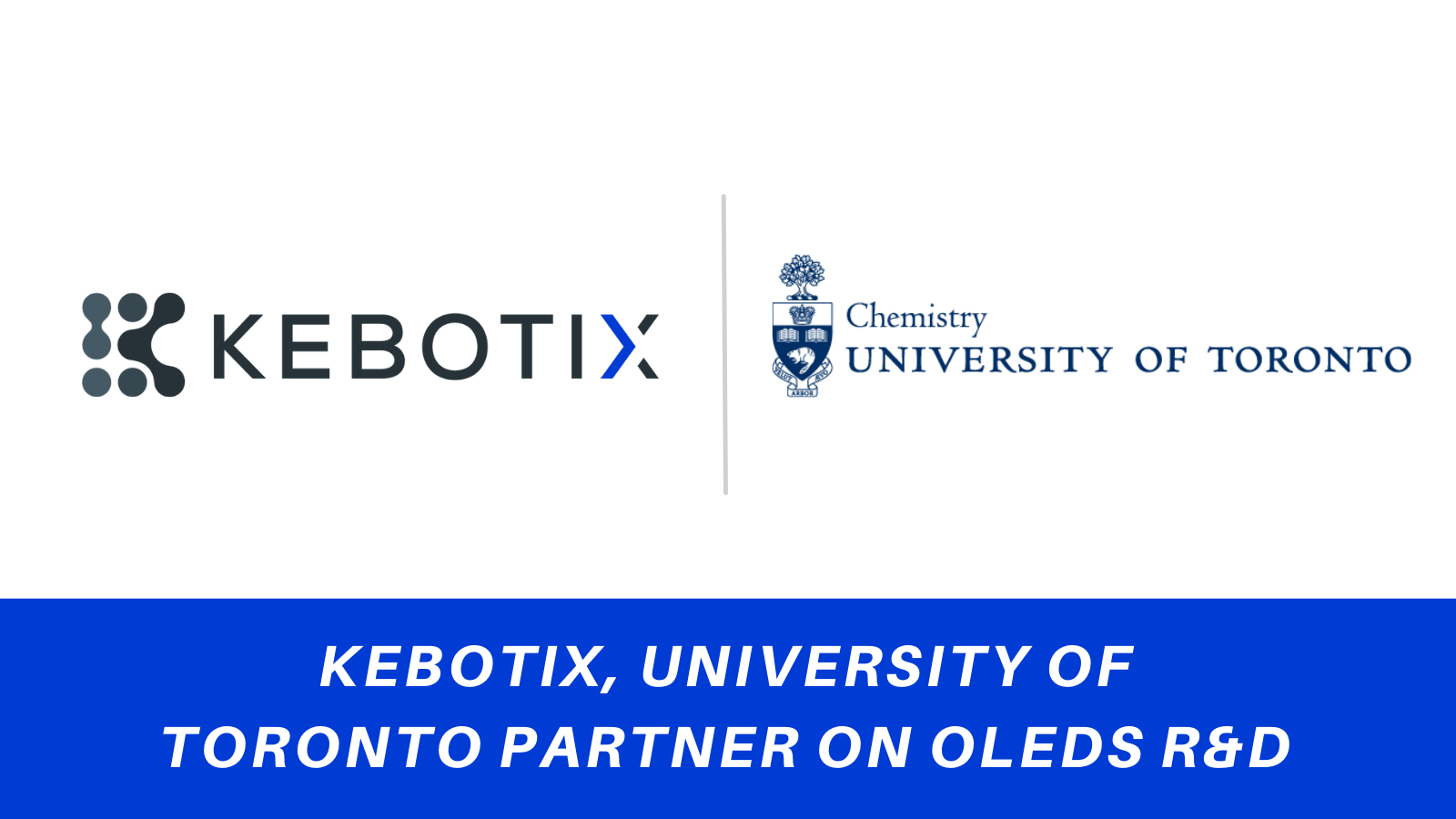Kebotix, University of Toronto Partner on OLEDs R&D
Kebotix, University of Toronto Partner on OLEDs R&D
Work Centers on New Class of Molecules
CAMBRIDGE, Mass., April 12, 2022 – Kebotix, a technology platform company for new chemicals and materials, is partnering with the University of Toronto to evaluate a new class of molecules for organic light-emitting diodes – or OLEDs – developed and patented by the university.
One of the University of Toronto’s draws to Kebotix is its proprietary closed-loop innovation platform. This architecture accelerates discovery by leveraging the ability of AI to learn chemical intuition when analyzing huge amounts of data simultaneously and synergistically with the oversight of science experts.
With its AI-powered prediction capabilities, Kebotix aims at accelerating time-to-market for what is potentially the next generation of OLED emitters, according to Alán Aspuru-Guzik, the professor of chemistry and computer science. His lab made the discovery of a range of compounds that have both inverted singlet-triplet gaps and are emissive — a rare combination of properties that can be key to dramatically enhancing OLED efficiency.
“Partnering with Kebotix will put the new class of OLED molecules we discovered and patented into actual devices much faster,” said Aspuru-Guzik, also a Kebotix founder. “These molecules are a breakthrough in that they solve insufficient long-term device stability due to decomposition processes caused by excited triplet states. That’s one of the major issues of current emitters.”
Moreover, the new molecules class covers the entire visible light spectrum and improve on OLEDs’ efficiency to convert electricity to light,” according to Dr. Semion Saikin, Kebotix’s chief science officer.
OLEDs are ubiquitous in the electronics market, having found their way into smartphones, computers, televisions, handheld game consoles and other devices with flat-screen displays that demand high image quality and low energy consumption. Because they emit less indoor air pollution due to having fewer toxic substances, OLEDs are more sustainable and have a higher recycling rate, among other environmental and consumer benefits.
“OLEDs are a technology that nearly everyone uses on a daily basis,” Aspuru-Guzik said in explaining why this area of science is a passion project for his lab. “OLEDs truly make the world around us, as we know it, possible. With the prospect of flexible and transparent screens, OLEDs are about to bring us into a new age of more immersive digital technology that ultimately will improve the lives of everyone around us.”
Today’s announcement is the latest in a series of OLED- and academia-related developments for Kebotix, and made just over a year since the Cambridge, Mass.-based technology company founded Kebotix Canada, a wholly owned subsidiary focused on advancing artificial intelligence and machine learning in the Toronto-Waterloo region, one of the world’s largest innovation centers.
Other recent developments include:
Kebotix discovered several new classes of OLED emitter molecules that, unlike traditional emitters, fit more than the conventional molecular vapor deposition technology that is widely used in display production. Discovered and developed into device prototypes in less than six months, the molecules are on target to begin testing with manufacturing partners later this year.
Kebotix was selected as the industry partner of a $15-million interdisciplinary research institute led by Colorado School of Mines and funded by the National Science Foundation. As the private-industry representative of the Institute for Data Driven Dynamical Design, or ID4 for short, Kebotix collaborates with 11 renowned and respected research universities to harness data for accelerated, cost-effective and sustainable materials discovery.
For further technical details on today’s announcement on the Kebotix-University of Toronto partnership, click here.
About Kebotix
Kebotix transforms discovery and development of breakthrough chemicals and materials for the 21st century, adding certainty to science by using today’s most advanced artificial intelligence, machine learning and robotics. By automating the scientific method using a proprietary closed-loop R&D process to predict and produce new chemistries in a self-driving lab, Kebotix’s digital platform empowers lab researchers. Myriad positive results include increased ROI and time-to-market being accelerated from years to mere months. From smarter windows and greener packaging to cleaner pigments and safer pesticides, Kebotix creates materials for a new age of innovation and a better, more sustainable place to live. For more information, visit www.kebotix.com.
About Alán Aspuru-Guzik
Alán Aspuru-Guzik is a professor of Chemistry and Computer Science at the University of Toronto and is also the Canada 150 Research Chair in Theoretical Chemistry and a Canada CIFAR AI Chair at the Vector Institute. He is a CIFAR Lebovic Fellow in the Biologically Inspired Solar Energy program. Aspuru-Guzik also holds a Google Industrial Research Chair in Quantum Computing. Aspuru-Guzik is the director of the Acceleration Consortium, a University of Toronto-based strategic initiative that aims to gather researchers from industry, government and academia around pre-competitive research topics related to the lab of the future.
TECHNICAL ADDENDUM TO RELEASE
Elaborating on the new class of OLED molecules developed in his U of T lab, Aspuru-Guzik made the following points:
In ordinary organic molecules, the first excited triplet state is lower in energy than the first excited singlet state. Consequently, electric excitation in OLEDs causes significant triplet population giving rise to various decomposition and decay pathways that do not lead to light production reducing the efficiency of devices.
Only a handful of molecules are known with their first excited triplet state higher in energy than their first excited singlet state and, hence, they are said to possess inverted singlet-triplet gaps. Until recently, however, such molecules that are also emissive were unknown and hypothesized to be very hard to realize.
Using a closed-loop simulation approach, Aspuru-Guzik’s lab discovered a range of compounds that have both inverted singlet-triplet gaps and are emissive.
